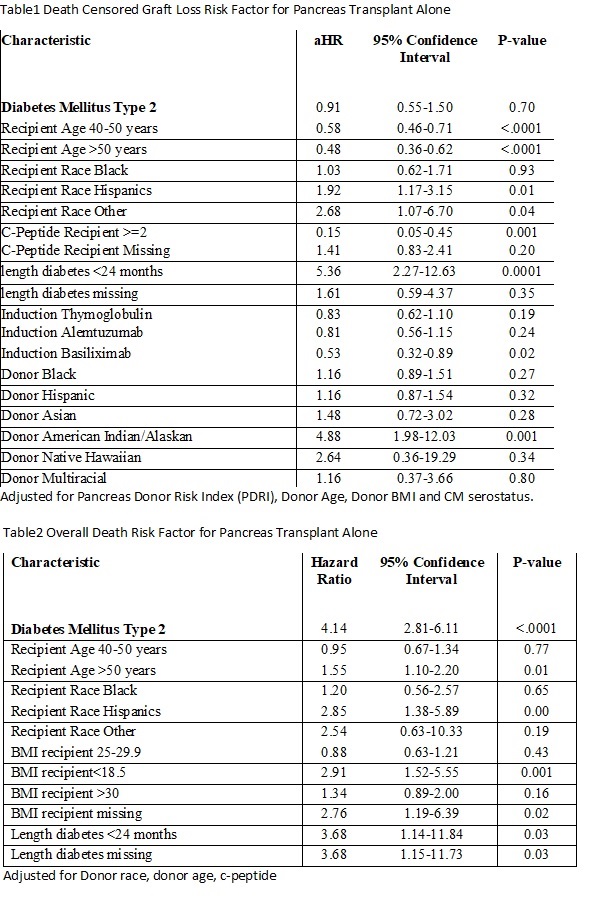Pancreas Transplants Outcomes in Diabetes Mellitus Type 1 and Type 2 in the 21st Century: Are They Two Different Populations?
1Washington University, St Louis, MO, 2Washington University in St Louis, Chesterfield, MO, 3Washington University in St. Louis School of Medicine, Saint Louis, MO, 4Washington University School of Medicine, Saint Louis, MO, 5SLU, St Louis, MO, 6Surgery, Washington University School of Medicine, Saint Louis, MO, 7Washington University School of Medicine at St. Louis, Saint Louis, MO
Meeting: 2022 American Transplant Congress
Abstract number: 1151
Keywords: Prognosis
Topic: Clinical Science » Pancreas » 65 - Pancreas and Islet: All Topics
Session Information
Session Name: Pancreas and Islet: All Topics
Session Type: Poster Abstract
Date: Sunday, June 5, 2022
Session Time: 7:00pm-8:00pm
 Presentation Time: 7:00pm-8:00pm
Presentation Time: 7:00pm-8:00pm
Location: Hynes Halls C & D
*Purpose: Pancreas alone transplant (PT) has been associated with decreased progression and regression of microvascular and macrovascular complications. In this current era of standardized immunosuppression, there have been few studies in PT comparing the type of diabetes mellitus type 1 (DMT1) and 2 (DMT2) with their outcomes. In this study, we explore the association between the DMT1 versus DMT2 and transplant outcomes in PT patients.
*Methods: We reviewed Organ Procurement and Transplantation Network (OPTN) data on pancreas alone transplants between 1/1/2000 and 6/12/2020 in patients aged ≥18 years. Exclusion criteria were simultaneous transplant, PT after kidney transplant, PT that was not due to DMT1 or DMT2, pancreas from donors after cardiac death. The outcomes were death censored graft loss (DCGL) and death. The association of each outcome was analyzed using multivariable Cox regression including adjustment for recipient, donor, and transplant characteristics (Table1 and 2).
*Results: After exclusion criteria, 1155 PTs were analyzed. Patients with DMT2 were not at higher risk for DCGL compared with those with DMT1 (multivariable-adjusted hazard ratio, aHR=0.91, 95% confidence interval, CI [0.55-1.50]). DMT2 was associated with increased risk for death aHR =4.14, 95% CI [2.81-6.11] compared with DMT1. Other risk factors associated with higher risk for DCGL were Hispanics recipients and other race for recipients, Donor Race of American Indian/Alaskan and length diabetes less than 24 months (Table1). Other risk factors associated with increased risk for death were recipients >50 years, recipients with a BMI<18.5, Hispanic recipients, and length of diabetes mellitus <24 months (Table2).
*Conclusions: In PT patients, there was no difference in DCGL between DMT2 and DMT1, but DMT2 was associated with increased risk for death, compared to DMT1. There were several morbidities that we could not adjust for such coronary artery disease, stroke, and recurrent infections. More granular data and studies with a longer follow-up are needed to determine the cause and characteristics of DMT2 in PT patients to explain the increased risk for death compared with DMT1.
To cite this abstract in AMA style:
Merzkani M, Murad H, Wang M, Hu V, Ji M, Al-Hosni Y, Alzahabi O, Zayed M, Wellen J, Lentine K, Chang S, Alhamad T. Pancreas Transplants Outcomes in Diabetes Mellitus Type 1 and Type 2 in the 21st Century: Are They Two Different Populations? [abstract]. Am J Transplant. 2022; 22 (suppl 3). https://atcmeetingabstracts.com/abstract/pancreas-transplants-outcomes-in-diabetes-mellitus-type-1-and-type-2-in-the-21st-century-are-they-two-different-populations/. Accessed December 19, 2025.« Back to 2022 American Transplant Congress

